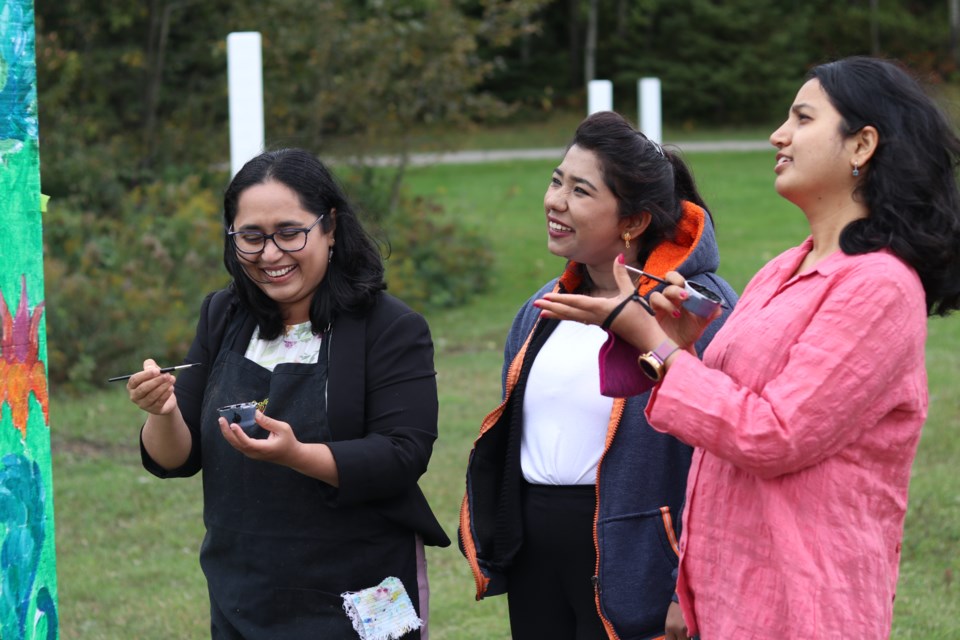For many participants, joining the Schumacher International Peace Park project was a great way to represent their culture and promote diversity and inclusion in the community.
The Schumacher Arts Culture and Heritage Association (SACHA) has partnered with the Schumacher Lions Club for the initiative.
The new park, located near Little Pearl Lake, includes a peace garden and decorated peace poles. Each pole will have “May Peace Prevail on Earth” written in a different language.
For the past week, members of the local cultural groups, artists and individuals have been working to get the peace poles ready for the official unveiling next week.
The unveiling ceremony is at noon on Tuesday, Sept. 21 at the Schumacher Lions Club Park behind the McIntyre Arena.
Sept. 21 also marks the International Day of Peace.
For Estela Aguilar Chow, the owner of Lady Luck Restaurant and Buffet in Timmins, it’s been fun working on the project.
“We have all the international poles there. When you go there, you feel like back home, in your own country,” she said. “Due to this pandemic, it’s nice that we get something to do in there. I love it.”
Artist Catharine Cribbs helped Agnes Okonmah, Vanessa September-Bentele and Elizabeth Esin work on the pole representing the continent of Africa.
Each side of the pole represents four African countries: Ghana, Nigeria, South Africa and Mali.
Esin is proud to represent the diverse cultures of Africa.
“We tried to pick something that is common among us and display it on the pole. It was nice, we did the best we could,” she said.
When they heard about the project, they decided to paint one pole together instead of taking one pole for each country, Okonmah explained. Each symbol and piece painted on the pole has a meaning of togetherness behind it.
“We’ve come far from Africa and we found ourselves in Canada. We just felt we had to be one instead of scattered,” she said. “We represented oneness, togetherness and love. Where there is love, there is peace.”
Centre Culturel La Ronde’s member Gilberte Mathieu incorporated the centre’s logo, fleur-de-lis and the McIntyre headframe on the pole.
“We like to show our colours, that’s why it’s going to be in green and white,” she said. “I taught for 32 years at Thériault. So, I was always proud to be a French teacher and I was always proud to be member of La Ronde, so I tried to do lots of stuff to show our colours.”
Some of the features Connie Lee painted on the Chinese pole include a panda, a lotus, a plum blossom, a Chinese good luck knot symbolizing united people, and a dove. Lee moved to Timmins four years ago.
“We don’t have a large Chinese community here. So it’s nice for them to see, OK, we still have people here that represent Chinese culture,” she said.
Karina Douglas-Takayesu, who’s half-Japanese, first learned about peace poles from this project. When she realized peace poles were first started in Japan by a poet and philosopher Masahisa Goi, she thought there should be something representing the country.
“Not just in Timmins, Canada overall, we’re still quite a small number of people. But they definitely left their mark on arts and culture, so I wanted to take part,” she said. “I liked the idea of public art. And also because the last 18 months, we haven’t been able to do anything and this is nice, meeting the other artists, being outside and doing something that people can enjoy afterwards.”
Tammy Racicot of Porcupine Art Club researched what to include on the Indian pole and ran the designs by the Timmins Local Immigration Partnership co-ordinator Shashanka Rangi, who let Racicot know what was appropriate.
The pole includes a lotus, which is a national flower of India, a peacock symbolizing beauty and grace, the Tree of Life, the and deities Ganesha, Radha and Krishna.
“India is a melting pot of different cultures with various traditions, art and languages,” Rangi said. “Family and passing traditions to generations is vital to Indian culture.”
Racicot said she can’t wait to see the finished park because it will look “amazing” with all the unique poles.
“I hope I represented everything for the culture. If somebody does come and sees it, I hope they understand and feel,” she said.
Artist Mélanie Frigault helped paint the Ukrainian pole. For her, it was a great idea to bring everyone together to paint, meet new people and learn about different cultures.
“Some of us aren’t from a multicultural group but we still get to know these people that I probably wouldn’t have never met before and learn some things,” she said.
Holly Buffalo Rodrique, who helped paint the Inuit pole, said it was a wonderful idea to have various cultures represented in the community.
“The peace poles are going to be a wonderful way to show the unity of community members,” she said. “It’s a wonderful way to show the community coming together as one."
